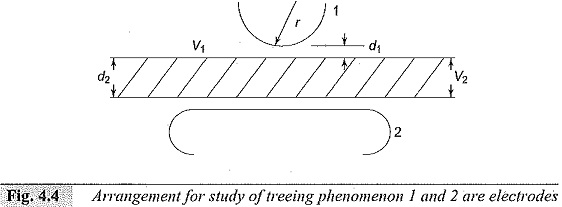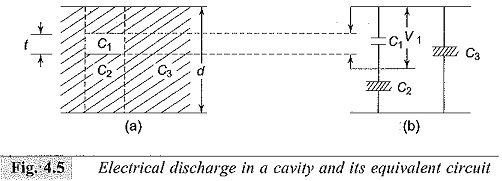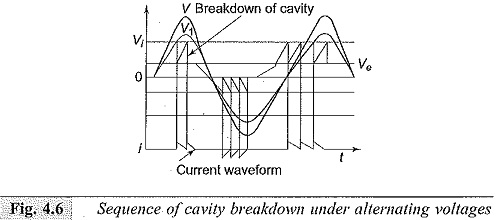Breakdown of Solid Dielectrics in Practice:
There are certain types of breakdown which do not come under either intrinsic breakdown or thermal breakdown, but actually occur after prolonged operation. These are, for example, breakdown due to tracking in which dry conducting tracks are formed on the surface of the insulation. These tracks act as conducting paths on the insulator surfaces leading to gradual breakdown along the surface of the insulator. Another type of breakdown in this category is the electrochemical breakdown caused by chemical transformations such as electrolysis, formation of ozone, etc. In addition, failure also occurs due to partial discharges which are brought about in the air pockets inside the insulation. This type of Breakdown of Solid Dielectrics in Practice is very important in the impregnated paper insulation used in high High Voltage Cables.
Chemical and Electrochemical Deterioration and Breakdown
In the presence of air and other gases some dielectric materials undergo chemical changes when subjected to continuous electrical stresses. Some of the important chemical reactions that occur are:
Oxidation: In the presence of air or oxygen, materials such as rubber and polyethylene undergo oxidation giving rise to surface cracks.
Hydrolysis: When moisture or water vapour is present on the surface of a solid dielectric, hydrolysis occurs and the materials lose their electrical and mechanical properties. Electrical properties of materials such as paper, cotton tape, and other cellulose materials deteriorate very rapidly due to hydrolysis. Plastics like polyethylene undergo changes, and their service life considerably reduces.
Chemical Action: Even in the absence of electric fields, progressive chemical degradation of insulating materials can occur due to a variety of processes such as chemical instability at high temperatures, oxidation and cracking in the presence of air and ozone, and hydrolysis due to moisture and heat. Since different insulating materials come into contact with each other in many practical apparatus, chemical reactions occur between these various materials leading to reduction in electrical and mechanical strength resulting in failure.
The effects of electrochemical and chemical deterioration could be minimized by carefully studying and examining the materials. High soda content glass insulation should be avoided in moist and damp conditions, because sodium, being very mobile, leaches to the surface giving rise to the formation of a strong alkali which will cause deterioration. It was observed that this type of material will lose its mechanical strength within 24 hrs, when it is exposed to atmospheres having 100% relative humidity at 70°C. In paper insulation, even if partial discharges are prevented completely, Breakdown of Solid Dielectrics in Practice can occur due to chemical degradation. The chemical and electrochemical deterioration increases very rapidly with temperature, and hence high temperatures should be avoided.
Breakdown due to Treeing and Tracking
Polymeric insulation is widely used for many engineering applications as they are tough, light in weight and possess excellent dielectric properties. Also, they can be easily fabricated in any complicated shape as required in practical use. However, their life when used in high voltage systems gets severely reduced by the degradation processes.
When a solid dielectric subjected to electrical stresses for a long time fails, normally two kinds of visible markings are observed on the dielectric materials. They are:
- the presence of a conducting path across the surface of the insulation;
- a mechanism whereby leakage current passes through the conducting path
The spreading of spark channels during tracking, in the form of the branches of a tree is called treeing. Tracking is the formation of a continuous conducting paths across the surface of the insulation mainly due to surface erosion under voltage application. While in use, the insulator progressively gets coated with moisture that causes increased conduction leading to the formation of surface tracks.
Consider a system of a solid dielectric having a conducting film and two electrodes on its surface. In practice, the conducting film very often is formed due to moisture. On application of voltage, the film starts conducting, resulting in generation of heat, and the surface starts becoming dry. The conducting film becomes separate due to drying, and so sparks are drawn damaging the dielectric surface. With organic insulating materials such as paper and bakelite, the dielectric carbonizes at the region of sparking, and the carbonized regions act as permanent conducting channels resulting in increased stress over the rest of the region. This is a cumulative process, and insulation failure occurs when carbonized tracks bridge the distance between the electrodes. This phenomenon, called tracking is common between layers of bakelite, paper and similar dielectrics built of laminates.
On the other hand treeing occurs due to the erosion of material at the tips of the spark. Erosion results in the roughening of the surfaces, and hence becomes a source of dirt and contamination. This causes increased conductivity resulting either in the formation of a conducting path bridging the electrodes or in a mechanical failure of the dielectric.
When a dielectric material lies between two electrodes as shown in Fig. 4.4, there is a possibility for two different dielectric media, the air and the dielectric, to come in series. The voltages across the two media are as shown ( V1 across the air gap, and V2 across the dielectric). The voltage V1 across the air gap is given as,
where V is the applied voltage.
Since ε2 > ε1, most of the voltage appears across d1 the air gap. Sparking will occur in the air gap and, charge accumulation takes place on the surface of the insulation. Sometimes the spark erodes the surface of the insulation. As time passes, Breakdown of Solid Dielectrics in Practice channels spread through the insulation in an irregular “tree” like fashion leading to the formation of conducting chennels. This kind of channelling is called treeing.
Under a.c. voltage conditions treeing can occur in a few minutes or several hours. Hence, care must be taken to see that no series air gaps or other weaker insulation gaps are formed.
Usually, tracking occurs even at very low voltages of the order of about 100 V, whereas treeing requires high voltage. For testing of tracking, a number of international standard testing methods have been used. At present, the method that is generally preferred is the liquid contaminant inclined plane tracking method as described in the standards IEC 587 (1984) and ASTM-D-2303 (1984). IEC method is preferred as it can differentiate between two materials having the same initial tracking voltage but different times to track. Another method, which is also widely used, is described in the standard ASTM-D-495 (1973). In this method no contaminant is used. The numerical value of the voltage that initiates tracking is called the “tracking index” and is used to qualify the surface condition of the material under test.
Treeing can be prevented by having clean, dry, and Undamaged surfaces and a clean environment. The materials chosen should be resistant to tracking. Sometimes moisture repellant greases are used. But this needs frequent cleaning and regreasing. Increasing creepage distances should prevent tracking, but in practice the presence of moisture films defeat the purpose.
Usually, treeing phenomenon is observed in capacitors and cables, and extensive work is being done to investigate the real and natural causes of this phenomenon.
Breakdown due to Internal Discharges
Solid insulating materials, and to a lesser extent liquid dielectrics contain voids or cavities within the medium or at the boundaries between the dielectric and the electrodes. These voids are generally filled with a medium of lower dielectric strength, and the dielectric constant of the medium in the voids is lower than that of the insulation. Hence, the electric field strength in the voids is higher than that across the dielectric. Therefore, even under normal working voltages the field in the voids may exceed their breakdown value, and Breakdown of Solid Dielectrics in Practice may occur.
Let us consider a dielectric between two conductors as shown in Fig. 4.5a. If we divide the insulation into three parts, an electrical network of C1,C2 and C3 can be formed as shown in Fig. 4.5b. In this C1 represents the capacitance of the void or cavity, C2 is the capacitance of the dielectric which is in series with the void, and C3 is the capacitance of the rest of the dielectric. When the applied voltage is V, the voltage across the void, V1 is given by the same equation (4.7(a))
where d1 and d2 are the thickness of the void and the dielectric, respectively, having permittivities ε0 and ε1.. Usually d1 ≪ d2, and if we assume that the cavity is filled with a gas, then
where εr is the relative permittivity of the dielectric.
When a voltage V is applied, V1 reaches the breakdown strength of the medium in the cavity (Vi) and breakdown occurs. Vi is called the “discharge inception voltage“. When the applied voltage is a.c., breakdown occurs on both the half cycles and the number of discharges will depend on the applied voltage. The voltage and the discharge current waveforms are shown in Fig. 4.6. When the first breakdown across the cavity occurs the voltage across it becomes zero. When once the voltage V1 becomes zero, the spark gets extinguished and again the voltage rises till breakdown occurs again. This process repeats again and again, and current pulses as shown, will be obtained both in the positive and negative half cycles.
These internal discharges (also called partial discharges) will have the same effect as “treeing” on the insulation. When the breakdown occurs in the voids, electrons and positive ions are formed.
Also, in each discharge there will be some heat dissipated in the cavities, and this will carbonize the surface of the voids and will cause erosion of the material. Channels and pits formed on the cavity surfaces increase the conduction. Chemical degradation may also occur as a result of the active discharge products formed during breakdown.
All these effects will result in a gradual erosion of the material and consequent reduction in the thickness of insulation leading to breakdown. The life of the insulation with internal discharges depends upon the applied voltage and the number of discharges. Breakdown of Solid Dielectrics in Practice by this process may occur in a few days or may take a few years.





